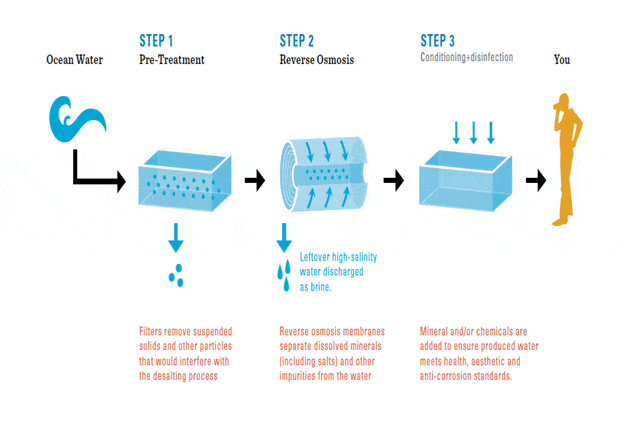The increasing population as well as unavailability of abundant Fresh Water has forced mankind to make sweet water from salty sea water. Among the various available technologies Reverse Osmosis turns out to be most economical and easy to operate technology which can be implemented very small 1000 lph capacity to mega capacity plants as 100 MGD.
Reverse osmosis is an increasingly common method of desalination, because of its relatively low energy consumption and Modular design. In recent years energy consumption has dropped to ~3 kWh/m3, with the development of more efficient energy recovery devices and improved membrane materials. According to the International Desalination Association, for 2011, reverse osmosis was used in 66% of installed desalination capacity (44.5 of 67.4 Mm3/day), and nearly all new plants. Other plants mainly use thermal distillation methods: Multi-effect distillation and Multi-stage flash.
Sea water reverse osmosis (SWRO) is a reverse osmosis desalination membrane process that has been commercially used since the early 1970s. Its first practical use was demonstrated by Sidney Loeb and Srinivasan Sourirajan from UCLA in Coalinga, California. Because no heating or phase changes are needed, energy requirements are low, around 3 kWh/m^3, in comparison to other processes of desalination.
The typical single-pass SWRO system consists of the following components:
- Intake
- Pretreatment
- High pressure pump
- RO Membrane Banks
- Remineralisation and pH adjustment
- Disinfection
Last two components are required if the product water is used for drinking purpose.
 Below is brief synopsis of Various sections of SWRO plant.
Below is brief synopsis of Various sections of SWRO plant.
There are three types of Intakes:
Deep Sea Intake: As the name suggests the sea water is lifted from deep sea near the sea bed so that consistent water quality is fed to membranes. This type is normally used for large plants.
Open Channel: An open Channel is built from Sea to the plant site to deliver sea water. This water is often has lot of silt and colloids, though this is cheapest option.
Wells: Water is extracted from the phreatic water-table level, at the coast. The well intakes have the advantage that the water is of higher quality, and accordingly it is a good option for desalination plants. Through the wells, a pump sucks the water, which is then subjected to different filtering systems so as to separate the sand and other impurities. The disadvantage of this type of seawater intake structure is that the hydraulic capacity will often be reduced by reason of the silting thereof (clogging with fine particles) that impedes the intake of the necessary flow volume.
Pretreatment normally consists of battery of filters to remove suspended matter & colloids. Sometimes DAF is also used to remove the floating oil if any. Few plants also have UF as pre-treatment to ensure consistent feed water quality.
High Pressure Pumps are required to overcome the Osmotic pressure of Saline water & have pressure ranging from 50 Bar to 75 Bar depending upon feed water TDS.
The spent energy from the reject is stream is recovered in large plant by Energy Recovery Devices (ERD). The plant size normally dictates the type of ERD. The Energy Recovery Turbine (ERT) and Pressure Exchangers (PX) are very popular.
RO Membrane Banks form the heart of the system & have piping manifolds, Membrane Housings and Semi-permeable membranes.
The permeate is often further treated by disinfecting it & remineralising it to make it stable (non corrosive), improve the taste and safe to drink.
The system is fitted with adequate instrumentation & control for safe & steady operations.
A very important aspect of SWRO is material selection. The wetted material needs to selected carefully for long life of the plant. High grade stainless steels like SS 904L, Duplex, Super Duplex, Bronze are some of the preferred materials for valves & piping.
